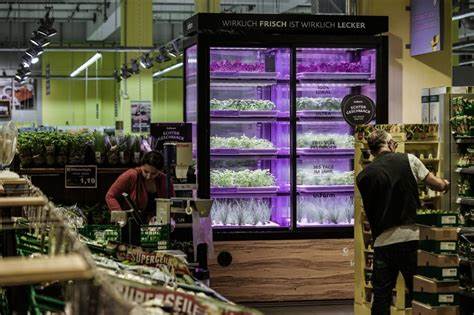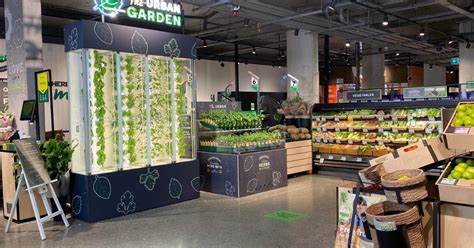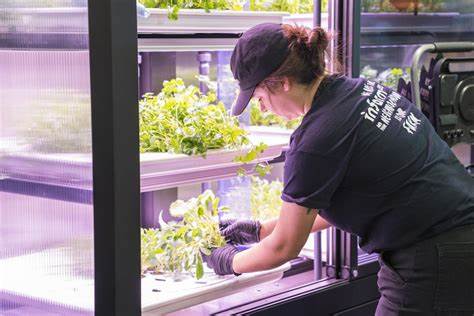
Vertical Farms and Grocery Stores: Revolutionizing the Future of Food
Introduction
The world’s population is rapidly growing, and with it, the demand for sustainable and efficient food production. This has led to the emergence of vertical farms and the continued development of grocery stores as crucial components of the food supply chain. In this article, we will explore the historical background, key concepts, main discussion points, case studies, current trends, challenges, controversies, future outlook, and the importance of vertical farms and grocery stores in the future food system.
Historical Background
The concept of vertical farms can be traced back to the early 20th century, with the works of American architect Frank Lloyd Wright and his vision of “The Illinois.” However, it wasn’t until the 21st century that vertical farms started gaining traction as a viable solution to the challenges of traditional agriculture. On the other hand, grocery stores have a long history that dates back to ancient markets in civilizations such as ancient Greece and Rome. Over time, grocery stores have evolved to meet the demands of consumers and play a vital role in the distribution and retailing of food.
Key Concepts and Definitions
Vertical farms are indoor farming facilities that utilize stacked cultivation systems, often in urban areas, to grow crops in a controlled environment. These farms use technologies such as hydroponics or aeroponics to provide plants with the necessary nutrients and light, eliminating the need for soil. Grocery stores, on the other hand, are retail establishments that offer a wide range of food products and play a crucial role in the food supply chain by providing accessibility and convenience to consumers.

Main Discussion Points
Point: Benefits of Vertical Farms
Vertical farms offer numerous benefits, including increased food production. By utilizing vertical space, these farms can produce higher yields compared to traditional agriculture methods. Additionally, vertical farms utilize resources efficiently, as they require fewer inputs like water and pesticides. Furthermore, vertical farms contribute to reduced transportation and emissions by being located closer to urban areas, reducing the distance traveled to deliver fresh produce.
Point: Role of Grocery Stores in the Food System
Grocery stores play a vital role in the distribution and retailing functions of the food system. They ensure that products from various sources, including vertical farms, reach consumers efficiently. Moreover, grocery stores offer accessibility and convenience to consumers by providing a wide range of food products in one location. They also have the power to influence consumer behavior and choices, as they curate the selection of products available.
Point: Integration of Vertical Farms and Grocery Stores
There is potential for on-site vertical farming in grocery stores, where fresh produce can be grown right in the store itself. This integration allows for a direct and sustainable supply chain, reducing the time and distance between harvest and sale. Collaboration between vertical farms and grocery chains can also lead to mutual benefits, such as increased brand reputation and customer loyalty. Ultimately, this integration benefits consumers by providing them with fresh, local produce.
Case Studies or Examples
Example: Gotham Greens and Whole Foods Partnership
Gotham Greens, a leading urban agriculture company, partnered with Whole Foods to build rooftop greenhouses on their stores. This collaboration allows Whole Foods to offer customers fresh greens grown on-site, reducing transportation and increasing the availability of locally sourced produce.
Example: Infarm’s Integration in Edeka Supermarkets
Infarm, a Berlin-based vertical farming company, has integrated their modular farming systems into Edeka supermarkets in Germany. This partnership allows Edeka to provide customers with a wide variety of fresh herbs and leafy greens, while also reducing the environmental impact of transportation.

Example: AeroFarms’ Vertical Farm Supplying Local Grocery Stores
AeroFarms operates a vertical farm in New Jersey that supplies local grocery stores with a variety of leafy greens. By being located near the stores, AeroFarms ensures that the produce is as fresh as possible, reducing spoilage and waste.
Current Trends or Developments
There is a growing adoption of vertical farming in urban areas, driven by the need for sustainable and efficient food production. Grocery store chains are also investing in vertical farms to secure a consistent supply of fresh produce and strengthen their sustainability credentials. Research findings on the sustainability and productivity of vertical farms continue to emerge, providing insights into optimizing vertical farming practices.
Challenges or Controversies
One of the challenges associated with vertical farms is the high initial investment and operating costs. The advanced technologies used in these farms require significant capital, making it inaccessible for some farmers. Additionally, consumer perception and acceptance of produce grown in vertical farms can be a hurdle, as some consumers may have concerns about the lack of natural soil-based cultivation.
Concerns about the environmental impact of vertical farms also exist. While these farms have the potential to reduce transportation and emissions, the energy requirements of indoor farming can be significant. Finding sustainable energy sources and optimizing resource usage are ongoing challenges that need to be addressed.

Future Outlook
The future holds great potential for increased integration of vertical farms and grocery stores. This integration can lead to a more sustainable and efficient food system, with shorter supply chains and reduced environmental impact. Vertical farming practices are expected to expand further in urban areas, making fresh produce more accessible to urban populations. Furthermore, technology and automation will continue to play a significant role in the industry, improving efficiency and productivity.
Conclusion
Vertical farms and grocery stores are revolutionizing the future of food. Vertical farms offer increased food production, efficient resource usage, and reduced transportation, while grocery stores ensure accessibility and convenience for consumers. The integration of these two components holds immense potential for a more sustainable and efficient future food system. As technology advances and consumer acceptance grows, vertical farms and grocery stores will continue to shape the way we grow and consume food.




